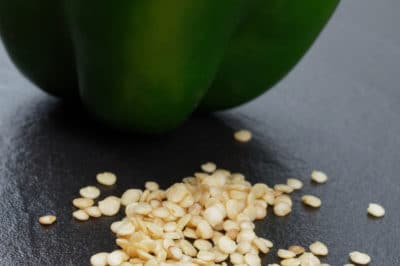Choose your variety
First, choose a bell pepper variety that will work for your garden. In USDA hardiness zones 9 and above most peppers will grow from seed outdoors easily. Seeds can be started indoors in cooler climates, but early ripening varieties will give you more production. Secondly, choose one for its color. Cultivars will ripen to red, yellow, orange, purple, or chocolate.
Early Bell Peppers:
- Nikita: 65 days, tri-colored fruits (green, orange,yellow,red)
- Miniature Bells: 55 days, red, yellow, and chocolate cultivares
- Purple Star: 65 days, full-sized brilliant purple fruit
Planting Seed
Wait until soil temperatures have warmed to 65°F (18°C) to plant seed outside. In cooler climates or to get a headstart on the season plant seeds indoors 8-12 weeks before the last frost.
Soak seeds overnight before planting to speed germination. Germinating them using the paper towel method is also convenient. Ideal germination temperature is around 70°F (21°C) so if seeds are indoors, keep them somewhere warm.
Plant seeds 1/2 inch deep into well-draining soil or potting mix. Include some compost in your potting mix or top an outdoor bed with two to three inches of compost.
Caring for Peppers
Seedlings that sprout indoors will need to go under fluorescent lighting as soon as they emerge from the soil. This will help them develop strong stocks. Protect outdoor seedlings from pest damage and watch them closely for signs of over or under watering.
Watering
Peppers should receive two inches of water per week. Adjust this amount to account for natural precipitation and if possible deliver water at the soil level rather than from above. Peppers do not like wet foliage.
Feeding
Organic peppers will thrive from the compost added at planting and will not need feeding until they begin to fruit. At this time, apply an additional two or three inches of compost as a mulch around the plants.
If using soluble fertilizers, avoid products with ammonium-based nitrogen. This can cause peppers to stay in a vegetative growth state preventing fruit from developing.
Troubleshooting
Seedlings that seem to weaken at the stem and fall over are suffering from damping off. This common problem is associated with too much moisture. Water them less and provide airflow.
Plants that drop blossoms or suffer from rotting fruit have a potassium deficiency. Add potassium and discontinue all nitrogen application.
